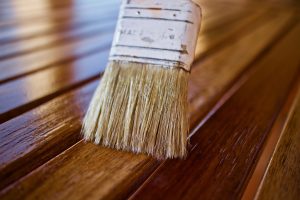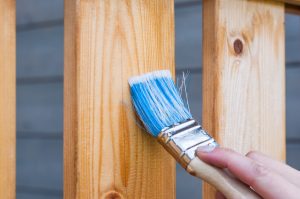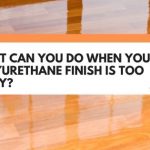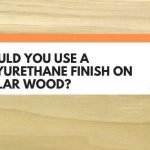In the world of woodworking we have so many options when it comes to choosing a wood finish.
And with such a wide range of finishes on offer, we can use it as an opportunity to really personalize our projects.
But, if you’re here because you can’t decide between a Lacquer and Polyurethane coat, stick around to learn which one is right for you.

This post may contain affiliate links to products that we receive a commission for (at no additional cost to you). Learn more here.
Is lacquer better than a polyurethane finish?
Well, both types of finish will leave a film that you can build up by adding more coats.
However, there are some key differences between Lacquer and Polyurethane that you must know before selecting them for your furniture or piece.
Let’s take an in-depth look at both of them and compare their pros and cons.
Related Post: Can You Put Lacquer Over A Wax Finish? (Best Practice Revealed)
Lacquer Explained
Lacquer isn’t a recent product.
It has been used for centuries as a durable, water-resistant clear finish. It is easy to repair as by adding more solvent the finish will become almost like new.
For that reason, experts call it one of the hardest topcoat finishes in the industry.
Today, this finish is available in both brush-on and spray styles.
Spray lacquer gives quick results and doesn’t require any special skills; even a novice can use spray lacquer for a finish.
But brush-on style finish looks a bit more lavish and clean compared to spray lacquer. The only drawback, however, is it takes more time and effort.
Before you opt for a lacquer finish, bear in mind it is often confused with Shellac. This happens because Shellac comes from the lac beetle.
Therefore, some people think both are the same.
But the reality is different. The actual lacquer finish is derived from the resin of a specific tree. It doesn’t come from the lac beetle. Besides, in the lacquer finish, the resin is refined and mixed with thinner to create the common finish.
Plus, the great thing about lacquer finish is that it dries quickly – in under 15 minutes. And you can easily apply two more coats in less than an hour.
Due to this speedy dry time, woodworkers don’t have to deal with any dust problems. That’s why it this finish is often used for quick simple projects that require basic protection immediately.
Today, we have many types of lacquer finishes, such as:
Nitrocellulose Lacquer
This finish is heavily used in the car and music industry. It has a reddish hue to it that gives a beautiful shine and lushness to the wood that makes it look exclusive – although it can tend to splinter and crack over time.
Urushiol-Based Lacquer
This lacquer type is very hard compared to others. It is unique in the lacquer finish category because it is water-based and takes time to dry. Apart from this, you need to give this finish proper oxidation and polymerization to set.
Acrylic Lacquer
The acrylic Lacquer finish is perhaps one of the most famous finishes in the market since it is often used on popular wood types such as oak and cedar.
It is long-lasting, scratch-resistance, and prevents yellow-staining issues that are present in some other finishes.
Pros
- The lacquer finish is impervious to water and other liquids.
- It doesn’t require any special maintenance.
- It is environmentally friendly and less toxic to your health.
- It has a superior-quick drying time.
Cons
- It is difficult to remove scratches from its surface.

Polyurethane Explained
This finish type is used when a durable finish is desired.
In addition to that, a polyurethane finish brings out the wood’s natural beauty, whilst also creating a hard shell coating the wood and prolonging the quality look of the finish for years.
And in case you are wondering how it creates a hard shell coating, well, polyurethane has a microscopic chain of resin molecules that bond tightly to create a shell as it dries. For that reason, it is also more resistant to water, solvents, and abrasions.
Experts also call polyurethane a ‘curing’ finish too. Since, according to them, the chemical reaction it uses cannot be reversed. That’s why it is more durable, and nearly every top-rated manufacturer uses it as a topcoat finish.
Another great thing that makes polyurethane special is its shiny plastic-like look. It makes furniture look glossy and creative. However, these days, some professional woodworkers use a satin variant in an attempt to eliminate that plastic look.
Plus, compared to lacquer finish, using polyurethane requires a tad more finesse.
First, you must examine the surface and make sure it is completely free from dust.
Furthermore, if you are sensitive to fumes, you need to have a really good ventilation system setup in your workshop.
Also, never shake this product. Try to always keep it in a stable position, as shaking it again and again will introduce bubbles into the mixture. And those bubbles will mean you’ll end up with bumps all along the surface of your project.
Now, lets take a deeper look into the different types of polyurethane finish on offer…
Oil-Based Polyurethane
Without a doubt, the oil-based polyurethane finish is the best version of this finish type.
When used, this polyurethane type makes wood surfaces look exactly the way we would expect hardwood to look.
It has depth and also forms a hard film with only a few coats. The only downside is that it takes time to dry.
Water-Based Polyurethane
It looks like milk in the can but when you apply it on the wood, it is crystal clear.
This finish is known for preserving the wood color and it dries quickly too. The good thing about water-based polyurethane is that it can be cleaned with soap and water.
Water-Based Oil-Modified
There is another sub-category of polyurethane; it is a water-based oil-modified finish that looks cloudy in the can but dries tough – a while creating a solid amber-color film on the surface of furniture.
It has low VOC levels, (Volatile Organic Compounds, which are the haze-inducing gaseous fumes most finishing oils release into the air [https://www.epa.gov/indoor-air-quality-iaq/volatile-organic-compounds-impact-indoor-air-quality]), and it is compatible with all wood types.
Pros
- It works best on flat surfaces.
- It is resistant to heat, chemicals, and scratches.
- It gives a lustrous finish with depth.
- It doesn’t add any color to the wood.
Cons
- It takes a very long time to dry.
Final Thoughts
All in all, both products are unique with their own chemical makeup. But, if you are still baffled regarding what the key differences between both of them are, keep a few things in mind:
- Lacquer saves time and effort.
- A lacquers finish merges, whereas polyurethane’s are independent.
- Polyurethane is hard and more durable.
- Polyurethane creates a coating, but lacquer gets absorbed into the wood.
- And Lacquer is easy to apply.
So hopefully, these differences will make it easier for you to know which finish you should opt for on your next project… Good Luck!



